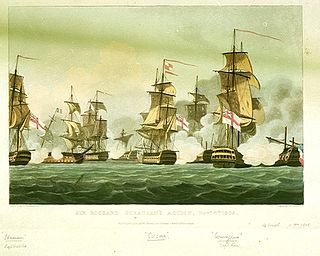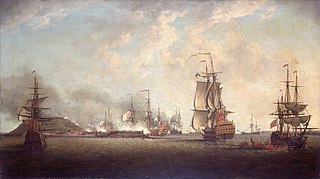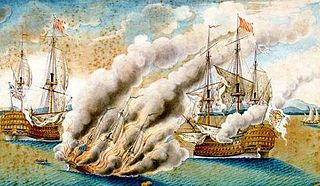
HMS Theseus was a 74-gun third-rate ship of the line of the Royal Navy.

HMS Bellona was a 74-gun Bellona-class third-rate ship of the line of the Royal Navy. Designed by Sir Thomas Slade, she was a prototype for the iconic 74-gun ships of the latter part of the 18th century. "The design of the Bellona class was never repeated precisely, but Slade experimented slightly with the lines, and the Arrogant, Ramillies, Egmont, and Elizabeth classes were almost identical in size, layout, and structure, and had only slight variations in the shape of the underwater hull. The Culloden-class ship of the line was also similar, but slightly larger. Thus over forty ships were near-sisters of the Bellona." Bellona was built at Chatham, starting on 10 May 1758, launched on 19 February 1760, and commissioned three days later. She was the second ship of the Royal Navy to bear the name, and saw service in the Seven Years' War, American Revolutionary War and the Napoleonic Wars.

HMS Colossus was a 74-gun third-rate ship of the line of the Royal Navy, launched from Deptford Dockyard on 23 April 1803. She was designed by Sir John Henslow as one of the large class 74s, and was the name ship of her class, the other being Warspite. As a large 74, she carried 24 pdrs on her upper gun deck, as opposed to the 18 pdrs found on the middling and common class 74s. She took part in the Battle of Trafalgar, and was broken up in 1826.

HMS Conqueror was a 74-gun third-rate ship of the line of the Royal Navy, launched on 23 November 1801 at Harwich. She was designed by Sir John Henslow as part of the middling class of 74s, and was the only ship built to her draught. Whereas the common class carried 28 18-pounder guns on their upper gun decks, the middling class carried 30, and only ten 9-pounder guns on their quarterdecks instead of the 12 of the common class.

HMS Revenge was a 74-gun third-rate ship of the line of the Royal Navy, launched on 13 April 1805. Sir John Henslow designed her as one of the large class 74s; she was the only ship built to her draught. As a large 74, she carried 24-pounder guns on her upper gun deck, rather than the 18-pounder guns found on the middling and common class 74s.

HMS Royal Oak was a 74-gun third-rate ship of the line of the Royal Navy, built by Jonas Shish at Deptford and launched in 1674. She was one of only three Royal Navy ships to be equipped with the Rupertinoe naval gun. Life aboard her when cruising in the Mediterranean Sea in 1679 is described in the diary of Henry Teonge.

HMS Culloden was a 74-gun third-rate ship of the line of the Royal Navy, built according to the dimensions laid out by the 1741 proposals of the 1719 Establishment at Deptford Dockyard, and launched on 9 September 1747. She was the first ship to bear the name, and was named for the Battle of Culloden, which had been fought the previous year.

HMS Saturn was a 74-gun third-rate ship of the line of the Royal Navy, launched on 22 November 1786 at Northam. The vessel served during the Napoleonic Wars with the Channel Fleet, taking part in the 1801 Battle of Copenhagen. With the beginning of the War of 1812, Saturn was modified to become a frigate designed to take on large American vessels of that type. Saturn was deployed as part of the blockading squadron of New York City from 1814 to 1815. From 1825, the vessel was in harbour service and was broken up in 1868.

HMS Princess Royal was a 90-gun second rate ship of the line of the Royal Navy, launched on 18 October 1773 at Portsmouth. During her career she was upgraded to a 98-gun ship, by the addition of eight 12 pdr guns to her quarterdeck.

HMS Prince of Wales was a 74-gun third rate ship of the line of the Royal Navy, launched on 4 June 1765 at Milford Haven. She was part of the Ramillies class of ships of the line designed by Sir Thomas Slade.

The Mars-class ships of the line were a class of two 74-gun third rates of the large class, designed for the Royal Navy by Sir John Henslow.

HMS Plantagenet was a 74-gun third rate ship of the line of the Royal Navy, launched on 22 October 1801 at Woolwich. She was designed by Sir William Rule as one of the 'large class' 74s, and was the only ship built to her draught. As a large 74, she carried 24-pounder guns on her upper gun deck instead of the 18-pounder guns found on the middling and common class 74s.

HMS Courageux was a 74-gun third rate ship of the line of the Royal Navy, launched on 26 March 1800 at Deptford. She was designed by Sir John Henslow as one of the large class 74-gun ships, and was the only ship built to her draught. Unlike the middling and common class 74-gun ships, which carried 18-pounder long guns, as a large 74-gun ship, Courageux carried 24-pounders on her upper gun deck.

HMS Bulwark was a 74-gun third-rate ship of the line of the Royal Navy, launched on 23 April 1807 at Portsmouth. She was designed by Sir William Rule as one of the large class 74s, and was the only ship built to her draught. As a large 74, she carried 24-pounder guns on her upper gun deck instead of the 18 pounders found on the middling and common class 74s.

HMS Warspite was a 74-gun third-rate ship of the line of the Royal Navy, launched in 1807. She served in the Napoleonic Wars and was decommissioned in 1815. After conversion to a 76-gun ship in 1817 she circumnavigated the world, visiting Australia. She was cut down to a single decker 50-gun frigate in 1840 and was decommissioned in 1846. She was lent as a boys' training ship to The Marine Society and was lost to fire in 1876.

HMS Eagle was a 74-gun third rate ship of the line of the Royal Navy, launched on 27 February 1804 at Northfleet.

HMS Rochfort was a 74-gun third rate ship of the line of the Royal Navy, launched on 6 August 1814 at Milford Haven. She was designed by the French émigré Jean-Louis Barrallier, and was the only ship built to her draught.
Lyme was a 52-gun third rate Speaker-class frigate built for the navy of the Commonwealth of England at Portsmouth, and launched in 1654.

HMS Neptune was a 90-gun second-rate ship of the line of the Royal Navy. She was built under the 1677 "Thirty Great Ships" Programme and launched in 1683 at Deptford Dockyard.

HMS Namur was a 90-gun second rate ship of the line of the Royal Navy, launched at Woolwich Dockyard in 1697.



















